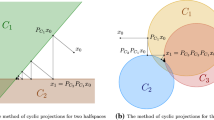Abstract
We present original solutions to four challenging mathematical puzzles. The first two are concerned with random processes. The first, here called The President’s Welfare Plan, can be reduced to computing, for arbitrary large values of n, the expected number of iterations of a program that increases a variable at random between 1 and n until exceeds n. The second one, called The Dining Researchers, can be reduced to determining the probability of reaching a given point after visiting all the others in a circular random walk. The other two problems, called Students vs Professor and Students vs Professor II, involve finding optimal winning group strategies in guessing games.
This work have been partially supported by the ECOS-NORD project FACTS (C19M03) and the Colciencias project CLASSIC (125171250031).
Access this chapter
Tax calculation will be finalised at checkout
Purchases are for personal use only
Similar content being viewed by others
Notes
- 1.
It would seem that in real life this kind of plan is often implemented except that the random amounts of money are not uniformly chosen and often include 0.
References
Ebert, T.: Applications of recursive operators to randomness and complexity. Ph.D. thesis, University of California, Santa Barbara (1998)
Euler, L.: Solutio problematis ad geometriam situs pertinentis. Commentarii Academiae Scientiarum Imperialis Petropolitanae 8, 128–140 (1736)
Feller, W.: An Introduction to Probability Theory and Its Applications, 2nd edn. Wiley, Hoboken (1971)
Ferguson, T.S.: Who solved the secretary problem? Stat. Sci. 4, 282–289 (1989)
Gardner, M.: Martin Gardner’s New Mathematical Diversions from Scientific American. Simon and Schuster, New York (1966)
Guo, W., Kasala, S., Rao, M., Tucker, B.: The Hat Problem and Some Variations, pp. 459–479. Birkhäuser, Boston (2006)
Guy, R.K.: Unsolved Problems in Number Theory, 3rd edn. Springer, Berlin (2004). https://doi.org/10.1007/978-0-387-26677-0
Lagarias, J.: The Ultimate Challenge: The 3x+1 Problem. American Mathematical Society, Providence (2010)
Ross, S.M. (ed.): Introduction to Probability Models. Academic Press, Cambridge (2007)
Russell, K.G.: Estimating the value of e by simulation. Am. Stat. 45, 66–68 (1991)
Sbihi, A.M.: Covering times for random walks on graphs. Ph.D. thesis, McGill University (1990)
Solov’eva, F.I.: Perfect binary codes: bounds and properties. Discrete Math. 213(1–3), 283–290 (2000)
Tao, T.: The Erdos discrepancy problem. arXiv e-prints arXiv:1509.05363 (2015)
Acknowledgements
We would like to thank Thomas Given-Wilson and Bartek Klin for bringing the third and fourth puzzles to our attention.
Author information
Authors and Affiliations
Corresponding author
Editor information
Editors and Affiliations
Rights and permissions
Copyright information
© 2019 Springer Nature Switzerland AG
About this chapter
Cite this chapter
Aristizabal, N., Pinzón, C., Rueda, C., Valencia, F. (2019). Make Puzzles Great Again. In: Alvim, M., Chatzikokolakis, K., Olarte, C., Valencia, F. (eds) The Art of Modelling Computational Systems: A Journey from Logic and Concurrency to Security and Privacy. Lecture Notes in Computer Science(), vol 11760. Springer, Cham. https://doi.org/10.1007/978-3-030-31175-9_25
Download citation
DOI: https://doi.org/10.1007/978-3-030-31175-9_25
Published:
Publisher Name: Springer, Cham
Print ISBN: 978-3-030-31174-2
Online ISBN: 978-3-030-31175-9
eBook Packages: Computer ScienceComputer Science (R0)




